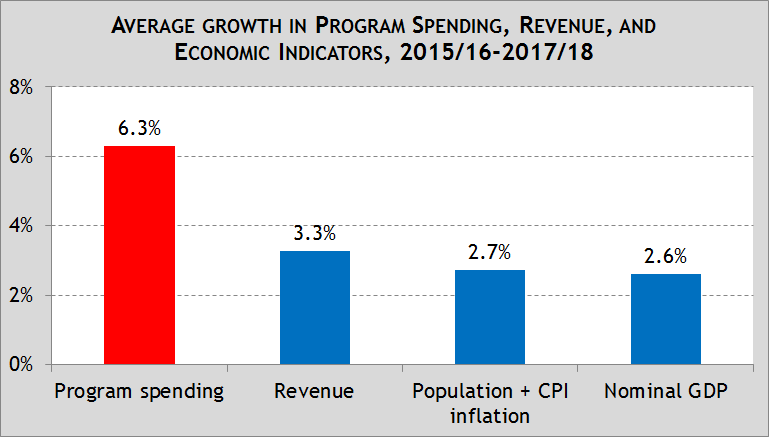Federal budget an opportunity for Ottawa to change big spending ways
Since coming into office, Prime Minister Justin Trudeau’s government has markedly increased spending, contributing to larger-than-promised budget deficits with no end in sight. Next week’s federal budget is an opportunity to change course.
Consider the government’s spending record thus far. It has increased program spending from $253.9 billion in 2014/15—the last full year the previous government held office—to a projected $304.9 billion this year (2017/18). This $51 billion increase in spending represents total growth of 20.1 per cent in just three years.
On an annual basis, program spending has increased by an average of 6.3 per cent each year from 2014/15 to 2017/18. By recent standards, that’s significant annual growth in spending. For the preceding decade, program spending grew by an average 2.2 per cent (excluding the unique post-recession spending increase of 17.1 per cent in 2009/10). That’s nearly a third of the current rate of annual spending growth.
Annual spending growth by the Trudeau government has also dwarfed growth in revenue (3.3 per cent), inflation plus population growth (2.7 per cent), and growth in nominal GDP (2.6 per cent) (see chart below).
With spending growing faster than the economy, federal program spending has increased as a share of the economy. Specifically, from 2014/15 to 2017/18 program spending has increased from 12.8 per cent of GDP to 14.3 per cent—representing considerable growth in the size of the federal government over a short time period.

To put the current level of federal spending into perspective, inflation-adjusted program spending per person is now $8,306—higher than any time in Canadian history except during the great recession. Even in 2009/10, the federal government spent only $69 more per person ($8,375). In other words, the Trudeau government is now spending more per person than any other federal government outside of a recession.
The government’s current fiscal plan is to moderate the growth of spending in the remaining years of its mandate. For 2018/19 and 2019/20, it plans to increase spending at an annual rate of 2.3 per cent. But that moderation is still not enough to balance the budget by the end of the mandate (2019/20)—something Prime Minister Trudeau promised to do in the 2015 election campaign.
To keep this promise, the government must change fiscal course in the years to come. Specifically, to balance the budget by 2019/20, it must reduce program spending by 1 per cent over the next two years or 0.5 per cent in each year—a modest adjustment given the marked 20 per cent growth in spending in the initial years in office.
Simply put, next week’s budget is an opportunity for the government change its big spending ways and keep the balanced budget promise made to Canadians.
Authors:
Subscribe to the Fraser Institute
Get the latest news from the Fraser Institute on the latest research studies, news and events.

